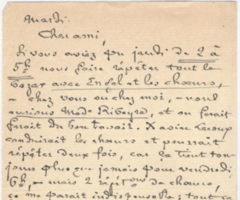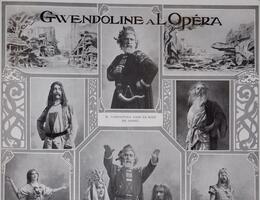Gwendoline
Opéra en deux actes et trois tableaux créé au théâtre de la Monnaie de Bruxelles.
Paul Lacome, deeply moved by the second act of Gwendoline played to him by his friend, Emmanuel Chabrier, immediately wrote to his wife: “It is simply sublime and I truly believe it has genius. But the difficulty of it! It is so difficult that I fear it is unlikely to get him anywhere and he’ll receive nothing but discouragement from it. That is the fate of people who are perched too high.” These words fairly accurately sum up the fate of Chabrier’s opera which, begun in the spring of 1879, was not performed at the Paris Opéra until December 1893. Catulle Mendès has reported how Chabrier came to see him one morning, saying: “I need an opera libretto in three days, I’m counting on you.” The librettist set to work on 10 March 1879, drawing his inspiration from a character in Augustin Thierry’s La Conquête d’Angleterre. The opera was given its premiere at the La Monnaie Theatre in Brussels, on 10 April 1886, and was a huge success. Unfortunately, the theatre was forced to go into liquidation. The conductor, Felix Mottl, then introduced the work to audiences across the Rhine in 1889, where it won acclaim. Despite its Wagnerian influences, Gwendoline contained some “magnificent melodic lines, powerful, vigorous choruses, and an orchestration, an acoustic texture, of incredible richness” (J.-P. Penin). The roles are very difficult: Gwendoline has to be able to combine a rich middle register with agile top notes in a range reaching from low B to high D flat, while the baritone Harald is often confined to the upper parts of his register. The diaphanous fabric of the love duet in Act II, “Soir nuptial”, with solo violin counterpoint, a supreme moment of reverie and peace before battle, is reminiscent of the troubling atmosphere of Berlioz’s duet between Ursula and Héro, while there are perhaps echoes of Ravel in the overture, evoking the moods of the sea so dear to the composer in the sunrise from Daphnis et Chloé.
Synopsis
In the 8th century, Harald, Danish ruler of the seas, lands in Saxony, hell-bent on looting and burning the country, when young Gwendoline, old Armel’s daughter, appears. Harald falls in love with her and asks her father for her hand in marriage. Armel agrees, but gives his daughter a dagger with which she is to kill her husband on their wedding night, while the Saxons descend on the Danes, whose strength has been sapped by eating and drinking at the wedding feast. Genuinely in love with Harald, Gwendoline tells him about this plan. After a languid love duet (“Soir nuptial”), Harald rushes into battle wielding the dagger that was to have killed him. The Danes flee or are slaughtered. When Armel orders his men to finish off Harald, severely wounded and trapped against a tree, holding nothing but a broken dagger, Gwendoline throws herself into her husband’s arms and stabs herself. As they die, watching the burning Danish ships casting their flames over the sea like an aurora borealis, the lovers “glorious and joyful [see] already the Valhalla of heroes and virgin warriors opening its doors to receive them.”(C. Mendès).
Documents and archives

Press illustration, Picture of a scene, Photograph



